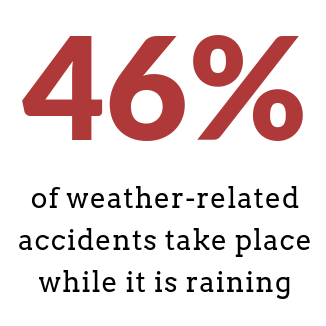Now that winter has officially begun, many drivers will at some point be faced with the challenge of driving in winter weather conditions such as ice, sleet and snow. People are right to be cautious about driving in snowy conditions. Winter weather creates additional hazards that require drivers to stay alert, slow their pace, and exercise defensive driving.
However, you might be surprised to find out that a breakdown of weather-related crash data from 2010-2012 by the Federal Highway Administration revealed that more crashes occur as a result of rainy weather conditions as opposed to winter weather conditions.
 According to the Federal Highway Administration, 23 percent of all accidents are weather-related. Weather-related crashes include crashes that take place during rain, sleet, snow, fog, severe crosswinds, and/or blowing snow, sand or debris.
According to the Federal Highway Administration, 23 percent of all accidents are weather-related. Weather-related crashes include crashes that take place during rain, sleet, snow, fog, severe crosswinds, and/or blowing snow, sand or debris.
Of the 1.3 million plus weather-related crashes each year, less than half involve a winter weather condition. While 74 percent of weather-related accidents occur on wet pavement (with 46 percent of weather-related accidents taking place while it is raining), far less take place during ice, sleet and snow conditions. In fact, of all the weather-related crashes, only 17 percent happen while it is snowing or sleeting, 12 percent occur on icy pavement, and 14 percent take place on snowy or slushy pavement. Some accidents may involve a combination of weather conditions, such as rainfall and wet pavement or a mixture of ice and snow.
On average, weather-related accidents result in 6,250 deaths each year and 480,000 injuries.
What is the takeaway? This report teaches us to regard all inclement weather conditions with caution and keep safety at the top of mind when traveling in rain or snow.




